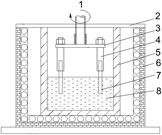Crossref Citations
This article has been cited by the following publications. This list is generated based on data provided by
Crossref.
Wang, Yong
Xing, Jiandong
Ma, Shengqiang
Liu, Guangzhu
He, Yaling
Yang, Duoxue
and
Bai, Yaping
2015.
Effect of Fe 2 B orientation on erosion–corrosion behavior of Fe–3.5 wt.% B steel in flowing zinc.
Corrosion Science,
Vol. 98,
Issue. ,
p.
240.
Wang, Yong
Xing, Jiandong
Ma, Shengqiang
Zheng, Baochao
Fu, Hanguang
and
Liu, Guangzhu
2016.
Interfacial morphologies and erosion–corrosion behavior of directional Fe-3.5 wt.% B steel in flowing liquid Zn containing 0.30 wt.% Al.
Corrosion Science,
Vol. 112,
Issue. ,
p.
25.
Ma, Shengqiang
Xing, Jiandong
He, Yaling
Fu, Hanguang
Li, Yefei
and
Liu, Guangzhu
2016.
Effect of orientation and lamellar spacing of Fe2B on interfaces and corrosion behavior of Fe-B alloy in hot-dip galvanization.
Acta Materialia,
Vol. 115,
Issue. ,
p.
392.
Ouyang, Xuemei
Chen, Guopeng
Yin, Fucheng
Liu, Ye
and
Zhao, Manxiu
2017.
Effect of Molybdenum on the Microstructures of As-Cast Fe-B Alloys and Their Corrosion Resistance in Molten Zinc.
Corrosion,
Vol. 73,
Issue. 8,
p.
942.
Wang, Yong
Xing, Jiandong
Fu, Hanguang
Liu, Yangzhen
Zheng, Kaihong
Ma, Shengqiang
and
Jian, Yongxin
2018.
Interfacial morphology and corrosion-wear behavior of cast Fe-3.5 wt.% B steel in liquid zinc.
Corrosion Science,
Vol. 131,
Issue. ,
p.
290.
Li, Kemin
Huang, Zhifu
Jian, Yongxin
Min, Ting
Lou, Xiaofei
and
Wang, Shaofei
2018.
Friction and Wear Behavior of Single-Phase Fe2B Bulk under Dry Sliding Condition.
Tribology Transactions,
Vol. 61,
Issue. 3,
p.
513.
Ma, Shengqiang
Xing, Jiandong
Fu, Hanguang
and
Wei, Shizhong
2018.
Cavitation - Selected Issues.
Li, Kemin
Huang, Zhifu
Ma, Hanwen
Wang, Shaofei
Qin, Chaofeng
and
Liu, Pengcheng
2019.
The tribological properties of bulk Fe2B with pre-oxidation treatment at 750°C in air.
Industrial Lubrication and Tribology,
Vol. 72,
Issue. 1,
p.
151.
Xu, Gaopeng
Wang, Kui
Dong, Xianping
Jiang, Haiyan
Wang, Qudong
Ye, Bing
and
Ding, Wenjiang
2020.
Multiscale corrosion-resistance mechanisms of novel ferrous alloys in dynamic aluminum melts.
Corrosion Science,
Vol. 163,
Issue. ,
p.
108276.
Wang, Lei
Zhang, Laiqi
Huang, Qian
and
Zhang, Changlei
2023.
Characterization and Corrosion Behavior to Molten Zinc of TiAl-Nb/NiCrAl Gradient Coatings.
Journal of Thermal Spray Technology,
Vol. 32,
Issue. 8,
p.
2491.
Wang, Lei
Zhang, Laiqi
Huang, Qian
and
Zhang, Changlei
2023.
Static and Dynamic Corrosion Behaviors of HVOF-Sprayed TiAl-Nb Coating in Molten Zinc.
Journal of Thermal Spray Technology,
Vol. 32,
Issue. 8,
p.
2507.
Shah, Intizar Ali
Lv, Ping
Ma, Shengqiang
Luo, Yang
Liu, Yusheng
Cui, Xudong
Guo, Pengjia
and
Xing, Jiandong
2024.
Effect of Si and prolonged time on interfacial morphologies and cavitation erosion behavior of directionally solidified Fe-B alloy in flowing liquid zinc.
Corrosion Science,
Vol. 236,
Issue. ,
p.
112281.
